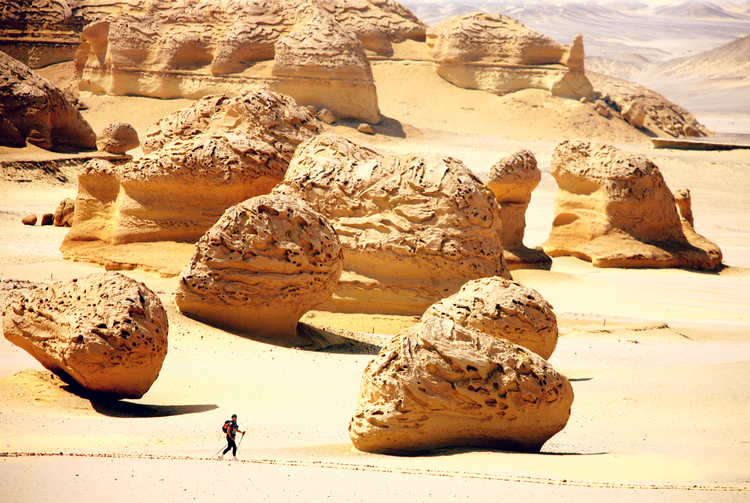We travel for many reasons. We travel to relax, to escape from our daily lives and rest. We travel to enjoy people and places different from what we know. We travel for adventure, to explore secrets hidden all over the globe. We travel to shape our world. Yet with this passion just outside our borders, how often do we find ourselves surrounded by camera flashes and tour groups wandering the most popular (and slightly overplayed) travel destinations?
If you’re looking for a vacation that is more than a trip, a vacation that engulfs you in unique kinds of beauty you’ve never seen before, that simultaneously satiate and inspire your wanderlust, look no further. Here is a list of the most beautiful and underexposed UNESCO World Heritage sites.
To be considered a World Heritage Site, a location must, among other criteria, “contain superlative natural phenomena or areas of exceptional natural beauty and aesthetic importance,” “bear a unique or at least exceptional testimony to cultural tradition or to a civilization,” and “be an outstanding example of a landscape which illustrates significant stages in human history.” These sites are some of the most beautiful natural places on Earth, we promise you won’t come home the same.
~ #shapeyourworld ~
Wadi Al-Hitan (Whale Valley)
Nestled just a few hours southwest of Cairo in Southern Egypt is Wadi Al-Hitan, The Valley of the Whales. Undiscovered until the winter of 1902, this site is a science enthusiast’s dream. This area, now protected and undergoing preservation, is a pre-historic graveyard of early ancestors of the whale.
The first fossil skeletons were found in 1902 and since then dozens of skeletons have been found, some measuring nearly 70 feet in length. The presence of fossils of other early animals such as sharks, crocodiles, sawfish, turtles, and rays found at Wadi El-Hitan makes it possible to reconstruct the surrounding environmental and ecological conditions of the time and served as some of the most pervasive shreds of evidence of the evolutionary transition from sea creatures to land dwelling animals.
Due to its fairly remote location, it is visited by roughly only 1,000 people each year. However its magnificent presence and its physical documentation of millions of years of marine life make it completely worth the journey.


When to visit? The best time to visit is sometime between October and April. Egyptian “winter” days usually hover around 70 degrees and in the sun it’s quite nice. Braver souls may opt to visit during the early summer months for better prices on flights, hotels and tours but beware of the heat. Exploring an Ancient tomb or pre-historic graveyard can be a rough experience in the blazing heat.
Kakadu National Park
What many people – even Australian natives – don’t realize is that this next site’s name come from a mispronunciation of the original inhabitants. The name Kakadu comes from a mispronunciation of Gagudju the name of one of the many aboriginal languages spoken there.
Aboriginal people have occupied the lands of the park for more than 40,000 years. As such the park is the site of incredible amounts of Australian history – cave paintings, rock carvings and other archaeological sites can be found all over the park. Its actually the largest concentration of aboriginal art on the planet while simultaneously being one of the world’s most beautiful places. Roughly the size of Israel, the park is Australia’s largest and still home to many aboriginal people.


When to visit? The Bininj and the Mungguy, the current aboriginal tribes living on the land, recognize six different seasons each with its own climate benefits and pitfalls.
The Yegge, May through June, is a time of cooler weather. This season allows visitors more freedom to walk and explore, free of the usual Australian heat.
Wurrgeng and Gurrung are the early and hot dry seasons. Running from June to October, this season is the least traveled. While an exceptionally warm season, early dry season is the time of the year when rates drop, leaving more room in the budget.
October to March, Gunumeleng and Gudjewg, are pre-monsoon and monsoon. While it’s slightly more difficult to travel at this time, this is when the park reaches heights of beauty as all the plant and animal life are being fed and replenished by the water.
Banggerreng, the most popular time of year, is the harvest time. Every April after the monsoons have passed and the park is at its height of beauty, Kakadu becomes an oasis and adventurers dream.
Monarch Butterfly Biosphere Reserve
100 km northwest of Mexico City lies the autumn’s most incredible natural phenomenon. Every year, Monarch Butterflies from all over North America arrive in Mexico after a nearly eight-month-long journey from East Canada across the continent. While it is still a mystery how these delicate creatures withstand this journey and make their way back to their winter home, every Autumn they arrive in the same place. Five of the eight colonies are located in Michoacán but only two are open to the public: Sierra Chincua in Angangueo and El Rosario in Ocampo (Open from November until March).

When to visit? During the peak of the season (the end of November through New Year’s Day) millions, perhaps a billion, butterflies from wide areas of North America return to the site and cluster on small areas of the forest reserve. While visiting during these times, people have related the sound of the beating wings to the light patter of raindrops. It is truly an exquisite experience.
Białowieża Forest

On the border between Poland and Belarus lies one of Europe’s most mystical hidden treasures. Bialowieza Forest is Europe’s last standing primeval forest.
Through extreme efforts for protection and conservation, the land had remained nearly undisturbed by various wars. The reserve is also home to many of the continent’s rarest animals including the iconic European Bison.
Although only around 58 square miles, the park is a small piece of a once expansive prehistoric forest. The Polish side of the forest, where most travelers choose to stay, includes the forest’s namesake village of Bialowieza. There you can find rooming and dining options as well as the quiet and laid-back charm of Polish lifestyle.
This site is one in particular not to miss, as the forest itself seems to enchant the surrounding cities with a magical air of ages past. The forest will mesmerize you, and take you back to the lush natural atmosphere of pre-civilization Europe.

When to visit? As with many vacation destinations, there is a high and low season for travels to Bialowieza. Head there between June and October. Summer temperatures and open air festivals will make your experience in the forest as well as in the rest of the city and country a lush and warm memory. For those willing to brave the cold, November through March offers much lower costs as well as the pristine vistas of a forest covered in snow. Do keep in mind that winter travel, while beautiful and cost effective, may make it considerably harder to see wildlife when exploring the park.
Socotra Archipelago

150 miles east of the Horn of Africa and 240 miles south of the Arabian Peninsula this trip is for only the bravest of travelers. Owned officially by Yemen, this island in the Arabian Sea is a rare gem.
Across the island, you can see landscapes ranging from 5,000 foot mountains, sandy dunes to oasis-like coastal plains. Although slightly difficult to get to this destination, it offers many options for entertainment and activities ones on the island.
With a bit of water for washing, a good meal and warm sleep surrounded by nature and the gentle sounds of the waves lapping at the shore, camping on the beaches can be a much-needed respite from the hustle and bustle of normal life.
Expert outdoors-men can bring and carry their own gear for maximum exploration possibilities, but amateur campers do not fret! Anyone can reserve a place in any one of the several campsites, like Dihamri and Homhil.
During the daytime, take a ride on a camel back. Take an afternoon stroll to see the region’s most iconic creatures, colorful vistas and mountains. During summer, Socotra also has excellent conditions for surfing and other water sports.
When to visit? The best time to come for this surfing is during the monsoon season, from June up to late August. In July the wind speed can reach up to 60 mph and it is recommended that only experienced surfers participate during this month. Not interested in surfing? Take your trip just after the monsoon season. Nature will be replenished and the sites will be glowing, later months also offer cooler temperatures and lesser rain.
Plitvice Lakes National Park
Situated in the mountainous Karst area of central Croatia, Plitvice Lakes basin is a geomorphological formation made of 16 interlinked lakes between Mala Kapela Mountain and Pljesevica Mountain. The lake system is divided into the upper and lower lakes: the upper lakes lie in a valley, are surrounded by lush forests and are linked by various waterfalls; the lower lakes, smaller and shallower, sit in limestone bedrock and are surrounded by underbrush.
This site is also a place to get a glimpse of very unique and rare European wildlife. For example, on many trails, you are able to witness wolves, many different kinds of birds and even the occasional European brown bear. While no swimming or water activities are permitted in the lakes, there are many means of transportation and activities throughout the park. The park maintains an electric boat for the purpose of getting from one side of the park to the other as well as a panoramic train tour that runs particular routes across the park.

When to visit? Plitvice Lakes basin is open daily all year round with longer hours in the summer. However, with summer being peak season and exceptionally warm, your best bet is to travel in autumn. The weather is cooler, seasonal shops and tourist attractions in surrounding areas are still open and hotel reservations are much easier to come by.



